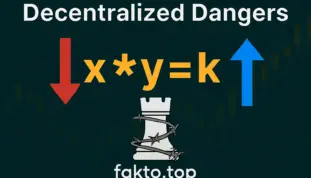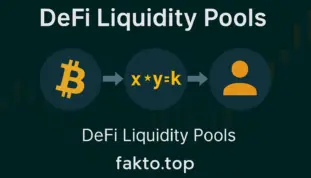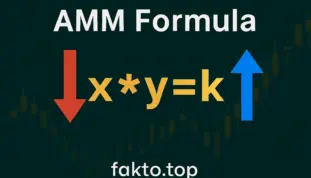Impermanent Loss Analysis: Mechanics, Arbitrage, and Mitigation Strategies
The Silent Drain: Analytical Guide to Impermanent Loss (IL) and Arbitrage Mechanics
Introduction: The Liquidity Provider’s Paradox
Impermanent Loss (IL) is the hidden cost that haunts many DeFi users who provide liquidity to decentralized exchanges. It represents the value difference between holding assets in a liquidity pool versus simply HODLing them in a wallet. For users who have interacted with DeFi Liquidity Pools and noticed unexplained portfolio erosion, IL often feels like a bug. But it is not. It is a mathematically inevitable consequence of how Automated Market Makers (AMMs) function.

This article offers a deep analytical breakdown of the mechanisms behind IL. We will dissect the AMM Formula, specifically the Constant Product Market Maker (CPMM) model, and examine how Arbitrage Bots enforce price equilibrium at the expense of liquidity providers. Our goal is to reframe IL not as a flaw, but as a structural cost of market efficiency in decentralized finance.
Section 1. The Mathematical Imperative: Deconstructing the CPMM Formula
To understand Impermanent Loss, we must first grasp the fundamental difference between traditional centralized exchanges (CEXs) and decentralized Automated Market Makers (AMMs). In a CEX, trades are matched via an order book — buyers and sellers agree on prices. In contrast, AMMs use a pool of assets governed by a deterministic formula to set prices. This pool acts as a reserve, and prices adjust automatically based on the ratio of assets within it.
The most common AMM model is the Constant Product Market Maker (CPMM), governed by the formula:
x × y = k
Here, x and y represent the quantities of two tokens in the pool, and k is a constant that must remain unchanged. This formula ensures that the product of the token quantities always equals the same value, regardless of trades. As users swap one token for another, the pool rebalances to maintain this constant product.
Let’s break this down further. Suppose a pool contains 1,000 USDC and an equivalent value of ETH — say, 1 ETH priced at $1,000. The pool is balanced in terms of value: $1,000 in USDC and $1,000 in ETH. The CPMM formula dictates that any trade must preserve the product x × y. If a user buys ETH from the pool, they add USDC and remove ETH, changing the ratio. To maintain k, the pool adjusts the price upward, making each subsequent ETH more expensive.

This automatic rebalancing is what causes Impermanent Loss. As the external market price of ETH rises, the AMM lags behind. Arbitrageurs step in to exploit this price gap, buying ETH cheaply from the AMM and selling it at a higher price elsewhere. The AMM’s formula forces the pool to sell more ETH to maintain balance, leaving the liquidity provider with fewer appreciating assets and more of the depreciating ones.
In essence, the CPMM formula enforces a 50/50 value balance, not a 50/50 quantity balance. This distinction is critical. The rebalancing mechanism ensures market efficiency but transfers value away from LPs during price divergence. IL is not a bug — it is a mathematical imperative.
Section 2. The Execution Layer: Arbitrage Bots and Price Divergence
For many liquidity providers, the moment of realization is painful: their portfolio shrinks, even though the market moved in their favor. They provided capital, the asset appreciated — and yet, they lost value. This is not a glitch. It’s the result of a silent but precise mechanism: Arbitrage Bots.

Impermanent Loss is not theoretical. It is executed, line by line, by external agents who exploit price gaps between centralized exchanges (CEXs) and AMMs. These bots are not malicious — they are simply efficient. They enforce the x × y = k formula by rebalancing the pool whenever external prices diverge. In doing so, they extract value from the pool, and that value comes directly from the liquidity providers.
Here’s how it happens:
- Step 1: The price of ETH rises on Binance or Coinbase.
- Step 2: The AMM pool (e.g., ETH/USDC) lags behind — it still offers ETH at a lower price.
- Step 3: An arbitrage bot detects the gap and buys ETH from the AMM pool.
- Step 4: The bot sells ETH on the CEX for a profit, rebalancing the AMM pool in the process.
Each time this happens, the pool loses ETH and gains USDC. The liquidity provider, who owns a proportional share of the pool, now holds fewer appreciating assets and more stable ones. The loss is not permanent — if prices return to their original ratio, the IL disappears. But in most cases, price divergence is persistent. The loss becomes real the moment the LP withdraws their funds.
Case Study: Why LPs Are Forced Sellers
Let’s take a closer look at the core mechanism. Suppose you provide liquidity to an ETH/USDC pool. ETH is trading at $1,000, and the pool is balanced. Suddenly, ETH surges to $1,500 on Binance. The AMM pool still offers ETH at a lower price — say, $1,200. Arbitrage bots rush in to buy ETH from the pool.
To maintain the x × y = k ratio, the pool must sell ETH and accumulate USDC. But this sale is not voluntary. You, as the LP, are mathematically forced to sell ETH — the appreciating asset — to maintain balance. You don’t press a button. The formula does it for you.
This is the heart of Impermanent Loss. You become a passive seller in a rising market. The arbitrage bot profits. You lose exposure to the upside. And unless trading fees offset this loss, your position underperforms simple HODLing.
Table 1: Impermanent Loss vs Price Change
This table illustrates the non-linear relationship between price divergence and IL. Even modest price changes can result in measurable loss.
| Price Change (Token A relative to Token B) | IL Percentage |
|---|---|
| 1.25x Change (↑25%) | ≈0.6% |
| 1.50x Change (↑50%) | ≈2.0% |
| 2.00x Change (↑100%) | ≈5.7% |
| 5.00x Change (↑400%) | ≈20.0% |
As the data shows, IL accelerates with price divergence. A 100% increase in price leads to a 5.7% loss. A 400% increase results in a staggering 20% loss. This is the silent drain — the cost of providing liquidity in a system that prioritizes price efficiency over LP preservation.
Section 3. Analytical Mitigation Strategies: Portfolio Design and Break-Even
Once liquidity providers understand the mechanics of Impermanent Loss (IL), the natural question becomes: how do I avoid it? But that question, while intuitive, leads to a dead end. IL cannot be avoided entirely — it is embedded in the structure of DeFi Liquidity Pools. The more effective approach is to manage IL as a cost, just like slippage or gas fees. The goal is not to eliminate it, but to ensure that the fees earned through Liquidity Provision exceed the loss realized through rebalancing.
This section presents three analytical strategies to mitigate IL through smarter portfolio design, fee analysis, and asset selection. These are not tricks — they are frameworks for active risk management in a system that rewards precision and awareness.
Strategy 1: The Correlation Hedge
One of the most powerful tools against IL is asset correlation. When two assets in a pool move together in price, the need for rebalancing diminishes. This means fewer arbitrage opportunities and less value leakage. High-correlation pairs like ETH/wETH or stETH/ETH are ideal examples. These pairs are essentially variations of the same asset, and their price movements are tightly linked.
In such pools, the IL Break-Even Point is easier to reach because price divergence is minimal. LPs retain exposure to the underlying asset’s performance while earning fees from trades. The risk shifts away from IL and toward smart contract security and protocol reliability.
Strategy 2: Fee-to-IL Break-Even Analysis
Every liquidity position should be benchmarked against its fee performance. Most AMMs offer trading fees of 0.3% or 0.05% per transaction. Over time, these fees accumulate. The key question is: do they offset the IL?
To answer this, LPs must calculate their cumulative fees earned and compare them to the IL incurred. If the fees exceed the loss, the position is profitable. If not, it’s underperforming. This is the essence of the Fees vs IL Analysis.
For example, if your position has earned 4% in fees but suffered 2% in IL, your net gain is 2%. But if IL reaches 6%, you’re underwater. This break-even framework allows LPs to set thresholds and exit criteria. It transforms passive liquidity provision into active portfolio management.
Strategy 3: Stablecoin Concentration (V3 AMMs)
With the rise of Uniswap V3 and other concentrated liquidity models, LPs now have the ability to target specific price ranges. This is especially powerful in Stable/Stable pools like USDC/DAI. Because these assets are designed to maintain parity, price divergence is rare — and IL is negligible.
In these pools, the primary risk shifts from IL to smart contract vulnerabilities and volume capture. LPs must ensure that their capital is deployed within the active trading range and that the pool attracts sufficient volume to generate fees. But when done correctly, this strategy offers capital preservation with consistent returns.
Table 2: IL Risk Matrix by Asset Correlation
This matrix categorizes IL risk based on asset type and correlation. It helps LPs align their strategy with their risk tolerance and performance goals.
| Pair Type | Price Correlation | Expected IL Risk | Primary LP Focus |
|---|---|---|---|
| Stable/Stable (USDC/DAI) | Near 100% | Negligible IL | Focus on Fees/Volume |
| Wrapped/Native (ETH/wETH) | Near 100% | Minimal IL | Focus on Smart Contract Security |
| Blue Chip/Stable (ETH/USDC) | Low/Medium | High IL Risk | Focus on Fees vs IL Buffer |
| Altcoin/ETH (New Token/ETH) | Volatile | Extreme IL Risk | Focus on Short-term APY |
This table is not just informational — it’s strategic. It allows LPs to categorize their positions and adjust their expectations. A stable/stable pool is ideal for capital preservation. An altcoin/ETH pool is a speculative play that demands constant monitoring. The matrix helps LPs move from reactive to proactive, from confused to confident.
Conclusion: IL as a Calculated Cost of Decentralization
Impermanent Loss is not a flaw in the system. It is the price of trustless, always-on liquidity — a structural cost paid by those who enable decentralized markets to function without gatekeepers. In traditional finance, market makers are compensated for risk. In DeFi, liquidity providers must learn to do the same, but without the institutional safety nets.
To thrive in this environment, LPs must transition from passive participants to active risk managers. The days of “set and forget” are over. Every pool, every pair, every fee tier is a strategic decision. The more volatile the assets, the more dynamic the strategy must be. IL is not something to fear — it is something to measure, monitor, and manage.
Creative Reflection: The Geometry of Loss
Think of an AMM pool as a suspension bridge. The tokens are the cables, stretched taut between two towers — price and liquidity. When the wind of volatility blows, the bridge sways. Arbitrage bots are the engineers, adjusting tension to keep the structure balanced. But someone must absorb the stress. That someone is the liquidity provider.
IL is the flex in the system — the invisible strain that keeps the bridge standing. Without it, the structure collapses. With it, the market flows freely. The question is not whether to bear the weight, but how to distribute it wisely.
Analytical Recommendations
Recommendation 1: HODL Benchmark
Always compare the value of your LP Token against the simple HODL value of the initial two assets. This is the only true measure of performance. If your LP position underperforms HODLing, it’s time to reassess.
Recommendation 2: Active Management
If you are in a volatile pool (e.g., Altcoin/ETH), treat the position as active trading. Set a maximum IL threshold — 5% or 10% — where you automatically withdraw to mitigate further loss. Use analytics, not emotion.
Recommendation 3: Risk Shifting
For capital preservation, shift your focus to V3 Concentrated Liquidity for stable pairs. In these pools, IL is negligible, and the risk moves to smart contract exploitation. Choose your battlefield wisely.
MANDATORY DISCLAIMER
This article is for informational and analytical purposes only and does not constitute financial, investment, or legal advice. Cryptocurrency investments are subject to high volatility and risk, including the potential for complete loss of capital. Always conduct your own research (DYOR) and consult with a certified financial professional before making any investment decisions. The author and publisher are not liable for any losses incurred based on the analysis provided.
